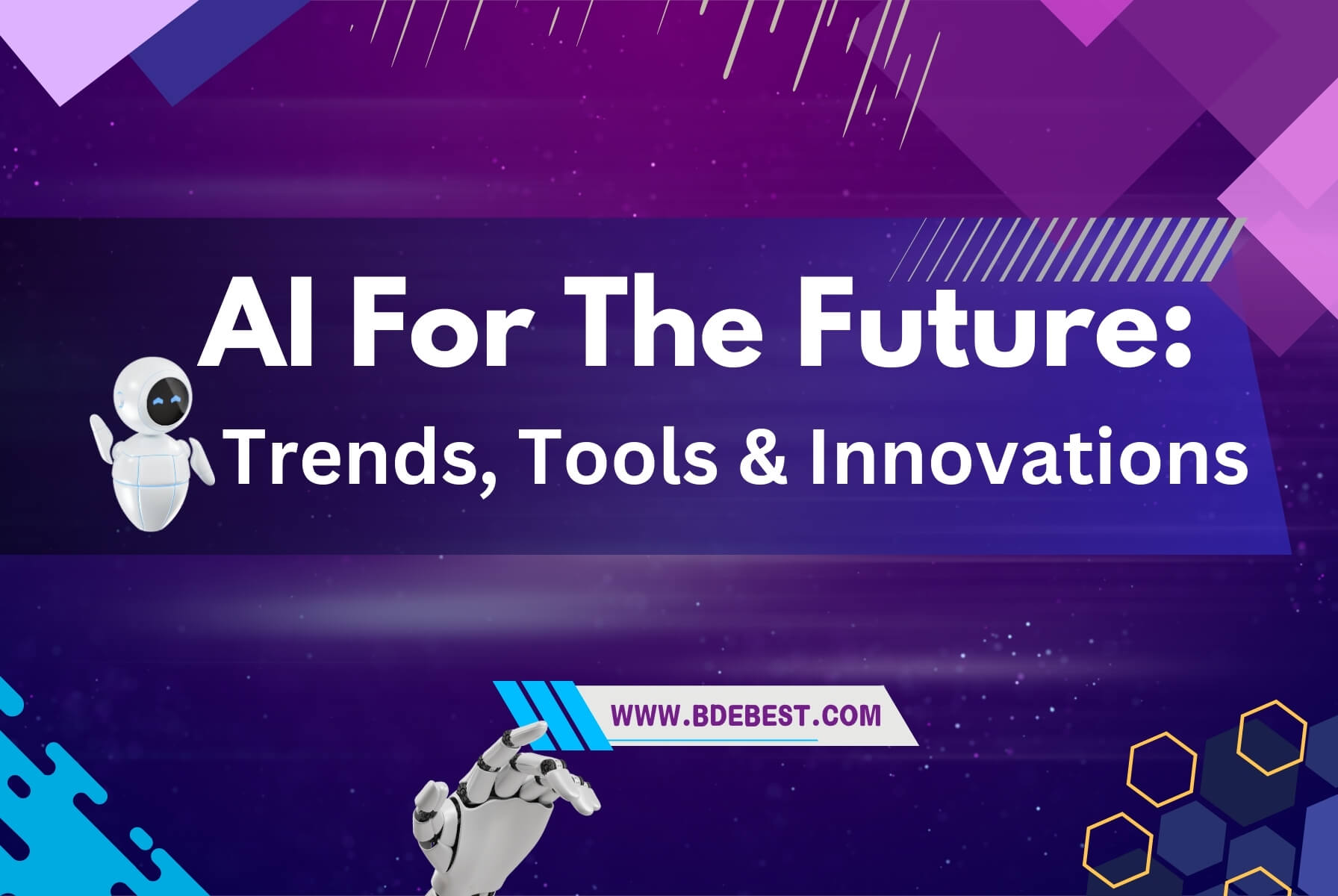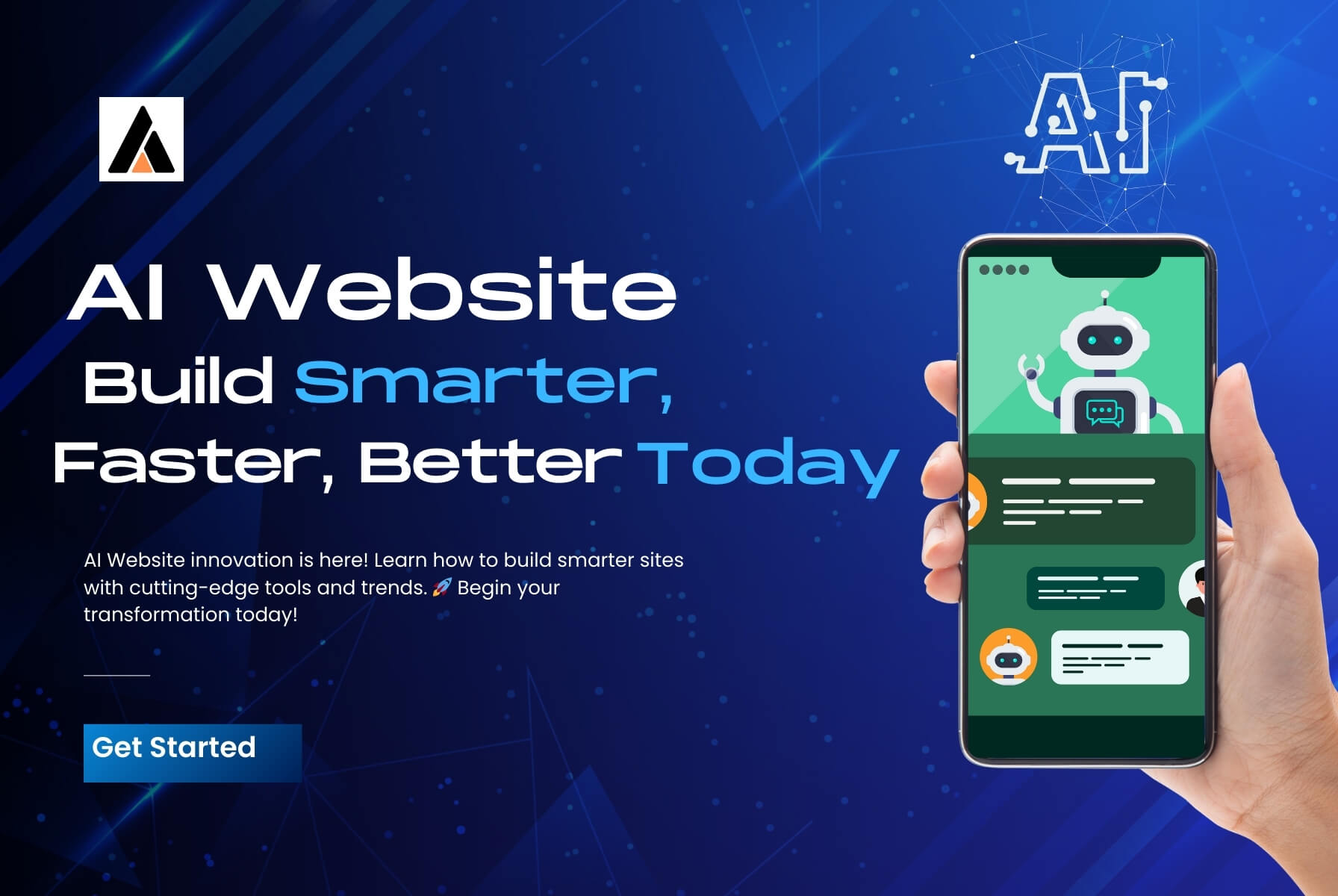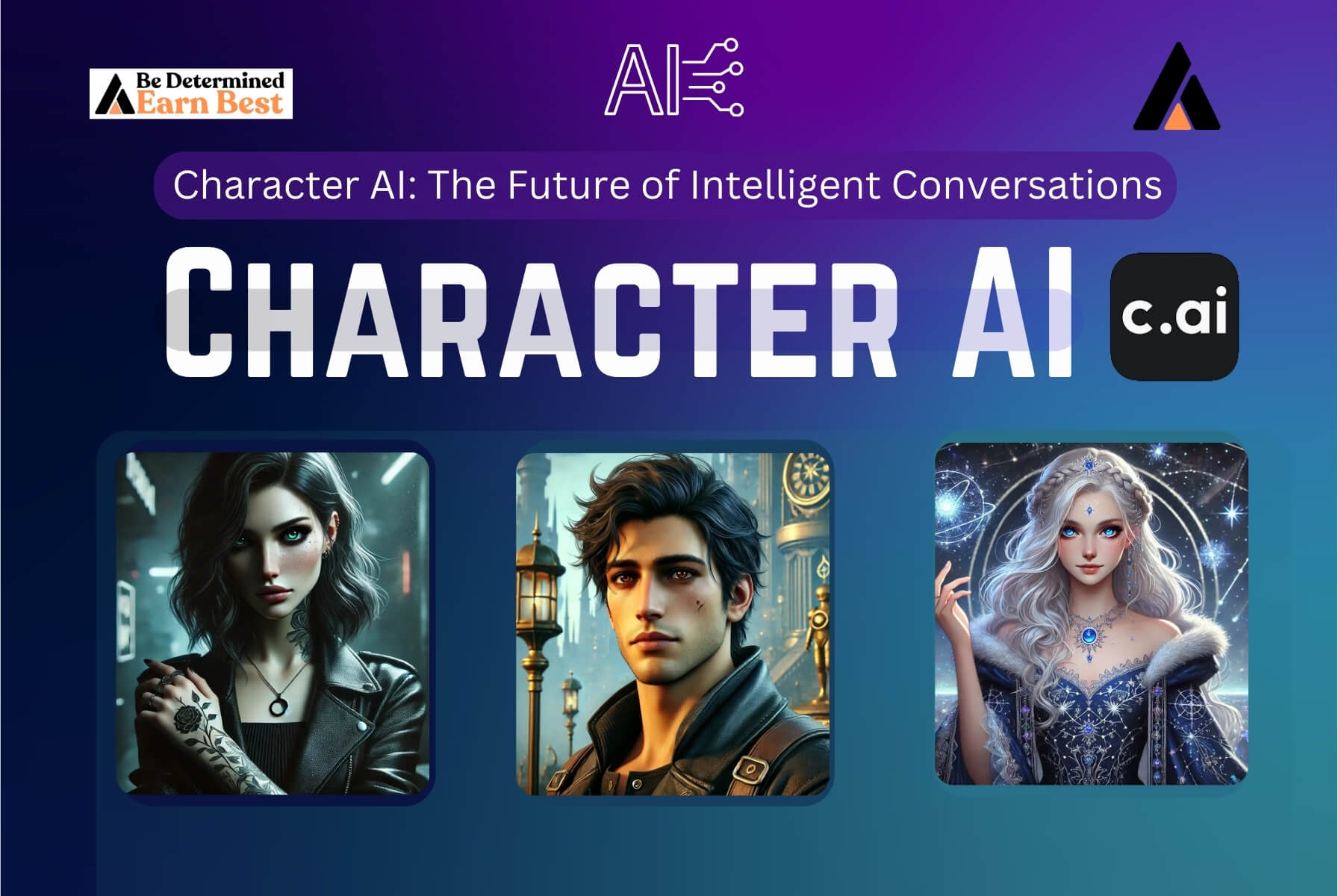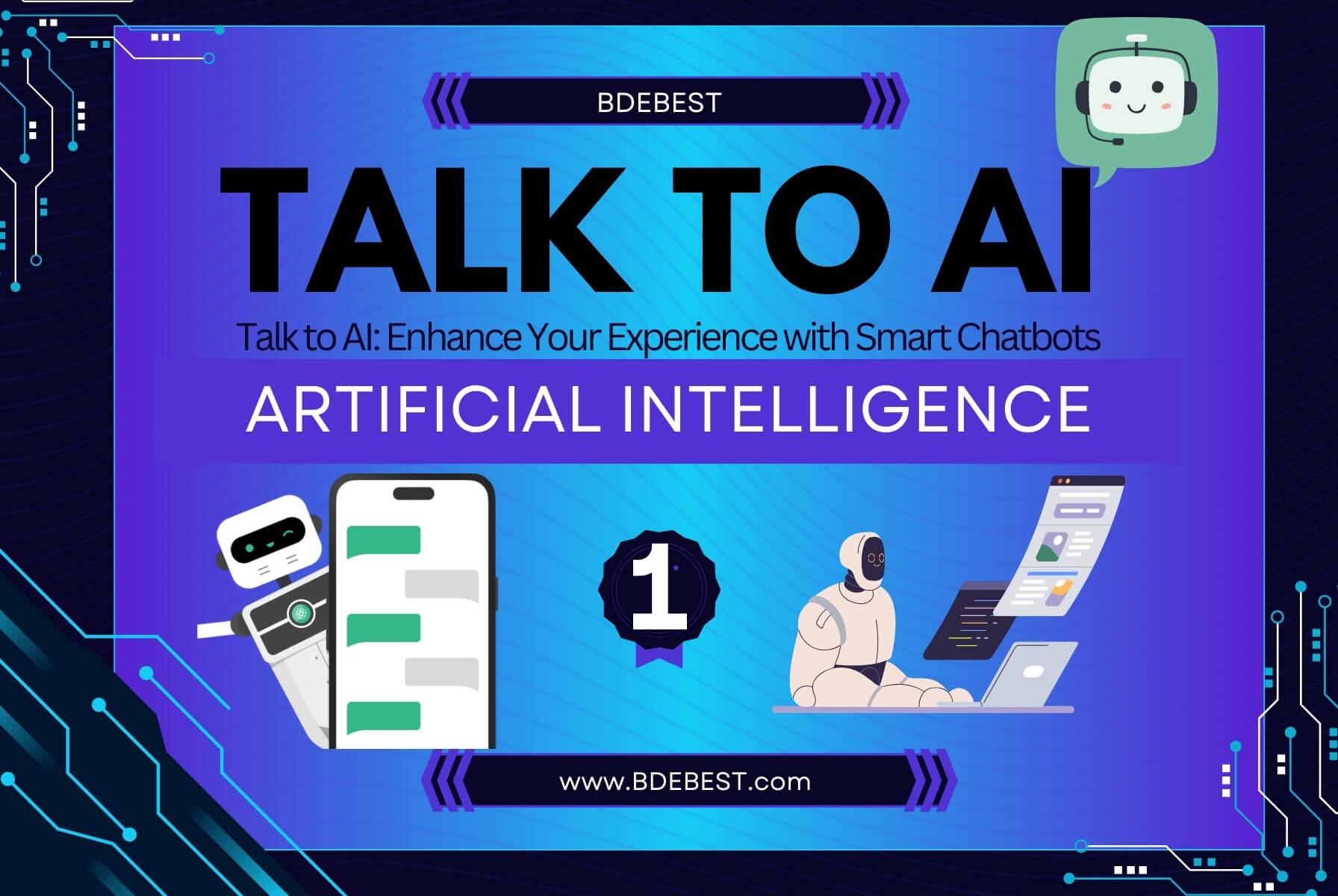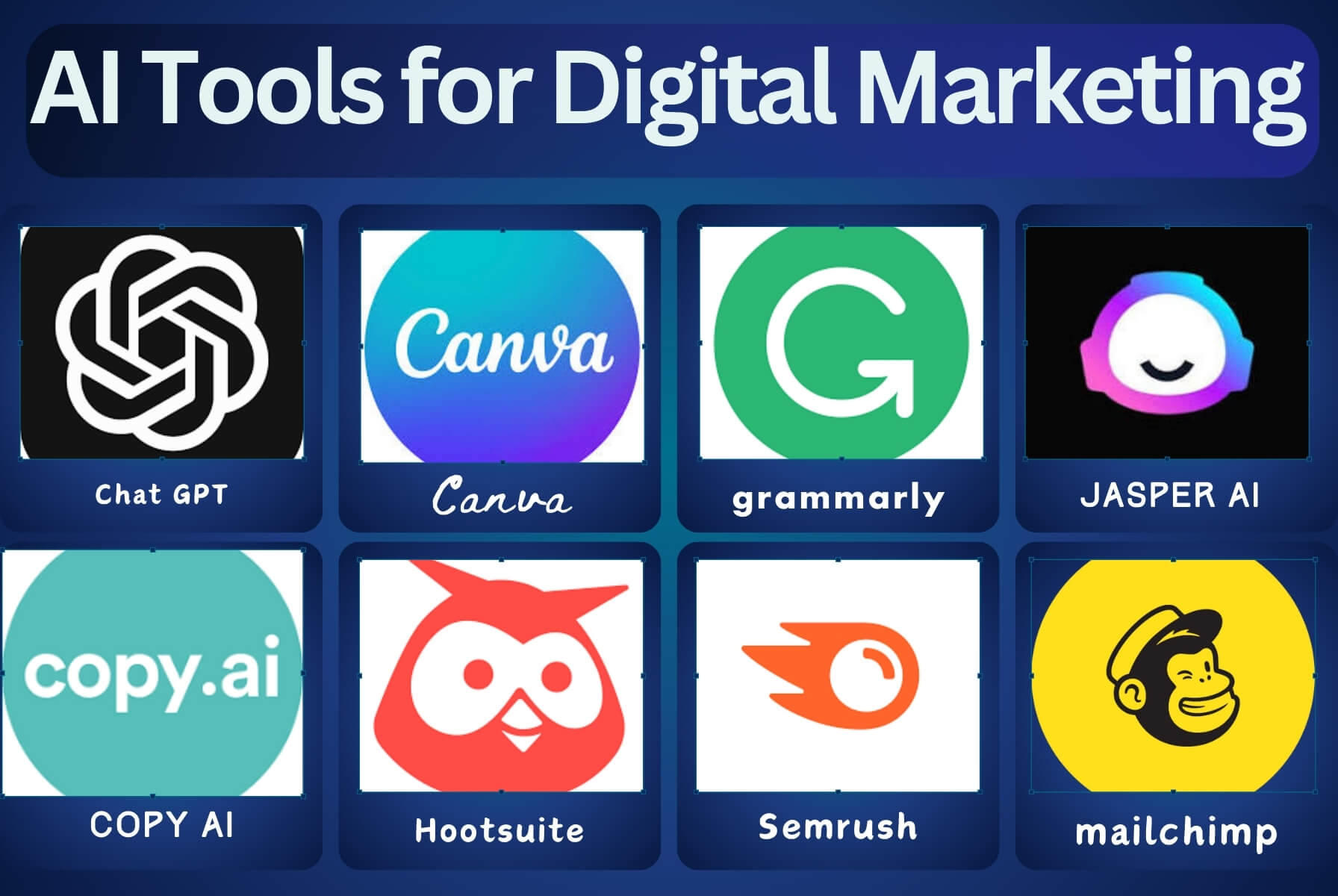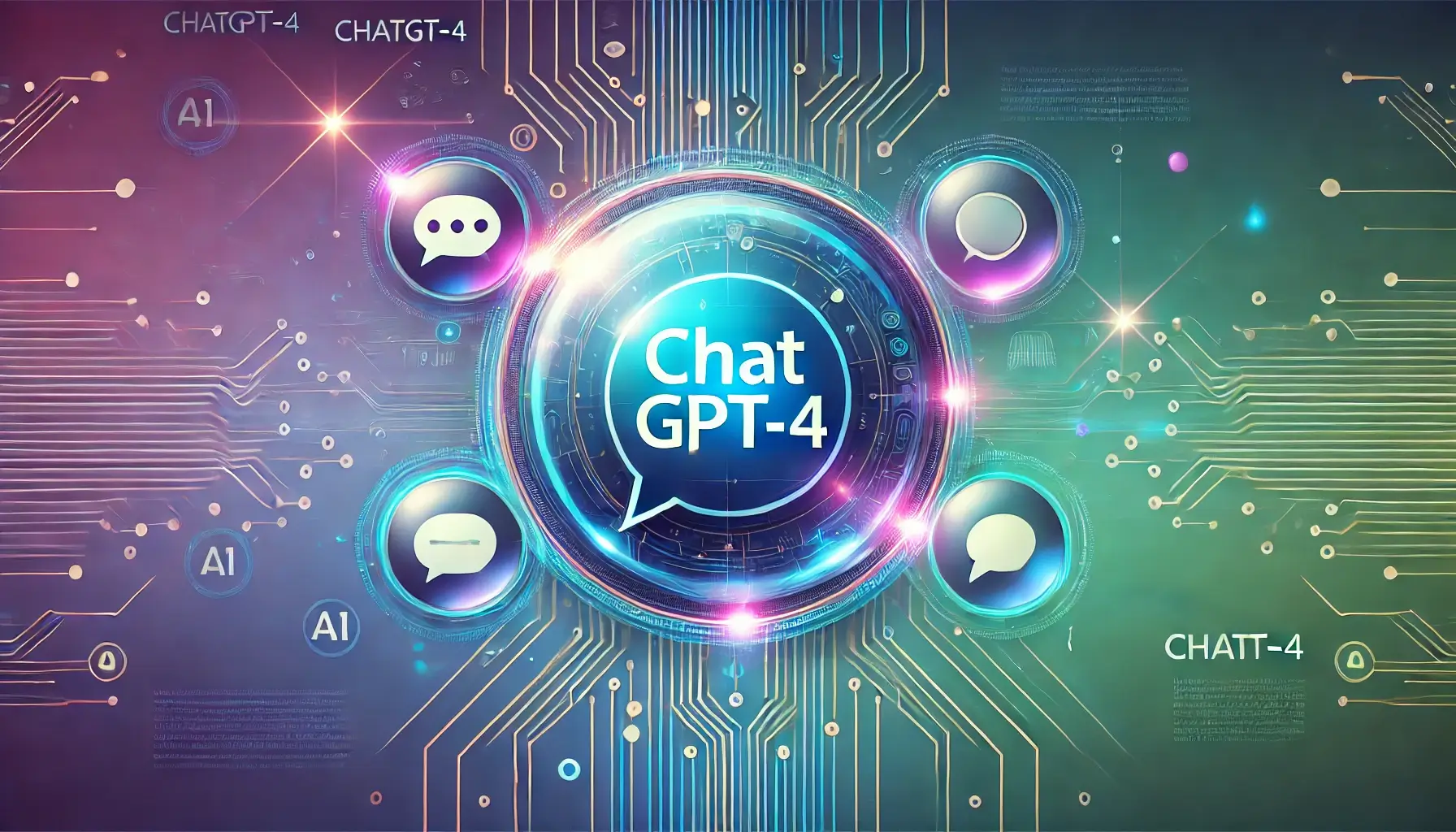Artificial Intelligence (AI) is no longer a futuristic dream—it is an integral part of our daily lives, revolutionizing industries, automating processes, and reshaping the way we work and interact with technology. From self-learning algorithms to intelligent automation, AI continues to evolve at an unprecedented pace, driving innovations across multiple sectors.
In this article, we explore AI for the future, discussing its rapid advancements, real-world applications, and what lies ahead in the next decade.
The Dawn of an AI-Driven Future
The Rapid Evolution of Artificial Intelligence
The journey of AI has been remarkable since its early days. Initially, AI systems relied on rule-based programming, where computers followed predefined instructions. Today, advancements in machine learning (ML) and deep learning enable AI to learn from data, improving its accuracy and decision-making capabilities over time.
Some of the most significant breakthroughs in AI include:
- Natural Language Processing (NLP): AI-powered chatbots and virtual assistants like ChatGPT and Siri understand and respond to human language.
- Computer Vision: AI-driven facial recognition, medical imaging, and autonomous vehicles rely on advanced image processing capabilities.
- Reinforcement Learning: AI systems, like DeepMind’s AlphaGo, learn by trial and error, achieving human-level performance in complex tasks.
How AI is Already Embedded in Daily Life
AI is not just limited to tech giants and research labs—it is embedded in our everyday experiences:
- Smart Assistants: Alexa, Google Assistant, and Siri help us set reminders, answer questions, and control smart home devices.
- Recommendation Engines: Streaming services like Netflix and Spotify use AI to suggest movies, music, and TV shows based on user preferences.
- Healthcare Innovations: AI-driven diagnostic tools help detect diseases early and assist doctors in making accurate diagnoses.
- Financial Services: Banks use AI to detect fraudulent transactions and provide personalized financial advice.
The Potential of AI to Redefine the Future
AI is poised to redefine nearly every industry, offering AI tools that change the future by improving efficiency, accuracy, and decision-making. Some of the most promising areas include:
- AI in Education: Personalized learning experiences tailored to students’ needs.
- AI in Transportation: The rise of autonomous vehicles and smart traffic management.
- AI in Business: Predictive analytics, AI-powered customer service, and automation of repetitive tasks.
This article explores The Future of AI, diving into upcoming trends, groundbreaking innovations, and the long-term implications of AI-driven technologies.
The Future of AI: Trends and Innovations to Watch
From Rule-Based to Self-Learning Systems
Early AI systems followed strict rules, requiring programmers to define every possible scenario. However, AI for the future relies on self-learning models that analyze vast amounts of data to improve their performance. Machine learning and deep learning techniques allow AI to:
- Identify patterns in data without explicit programming.
- Improve decision-making through experience and feedback.
- Adapt to new challenges, making AI systems more efficient and scalable.
Major Breakthroughs in AI Research
The last decade has seen remarkable progress in AI, with innovations that are reshaping industries:
1. GPT and Large Language Models (LLMs)
AI-driven language models, like OpenAI’s GPT-4, have revolutionized content creation, coding, and customer support, making AI a powerful tool for businesses and individuals alike.
2. AI-Powered Healthcare
- AI algorithms detect diseases like cancer and Alzheimer’s earlier than traditional methods.
- AI-assisted robotic surgery enhances precision and reduces recovery time.
3. Quantum AI: The Next Frontier
Quantum computing combined with AI has the potential to solve problems that are currently impossible for classical computers, including complex drug discovery and climate modeling.
The Rise of Artificial General Intelligence (AGI): Reality or Myth?
Artificial General Intelligence (AGI) refers to AI systems that possess human-like intelligence, capable of reasoning, learning, and adapting across different tasks. While today’s AI excels in specific areas (narrow AI), AGI remains an aspirational goal.
Experts are divided on AGI’s timeline:
- Optimists believe AGI could emerge within the next 20–30 years, fundamentally changing society.
- Skeptics argue that true AGI may never be achieved due to the complexity of human cognition.
Despite these debates, AI continues to advance, with increasing capabilities that blur the line between narrow and general intelligence.
Predictions for AI Advancements in the Next 10–20 Years
Looking ahead, AI is expected to drive transformational changes across industries:
AI and the Future of Work
- AI will automate repetitive tasks, freeing up human workers for creative and strategic roles.
- Demand for AI-related skills will grow, making AI literacy essential for career advancement.
AI in Business and Finance
- AI-powered analytics will optimize decision-making and risk management.
- Personalized AI-driven financial advisors will become more common.
AI in Everyday Life
- AI-enhanced smart cities will improve energy efficiency and urban planning.
- AI-generated content will transform entertainment, journalism, and marketing.
Ethical AI and Regulations
- Governments will introduce stricter regulations to ensure AI safety and fairness.
- Ethical AI frameworks will be crucial to prevent bias and discrimination in AI systems.
AI and the Future of Work: Will Robots Take Over Jobs?
One of the biggest concerns about The Future of AI is job automation. Many fear that AI-powered systems will replace human workers, leading to widespread unemployment. However, while automation is transforming the job market, it is also creating new career opportunities.
Automation’s Impact on Traditional Employment
AI-driven automation is already replacing repetitive and manual tasks across industries. Examples include:
- Manufacturing: Robots handle assembly lines, reducing labor-intensive work.
- Retail & Customer Service: AI-powered chatbots assist customers, replacing entry-level support roles.
- Finance: AI algorithms perform fraud detection and risk analysis more efficiently than humans.
While some jobs will be displaced, AI is augmenting human capabilities rather than eliminating roles entirely. Industries are evolving, requiring workers to adapt and reskill to stay relevant.
AI-Driven Industries vs. Human-Centric Roles
Certain industries face a higher risk of automation than others.
Industries with High AI Automation:
✔ Manufacturing & Logistics
✔ Customer Support
✔ Data Entry & Administrative Work
Industries that Require Human Expertise:
✔ Creative Professions (Writers, Artists, Designers)
✔ Healthcare & Emotional Support Services
✔ Strategic Business Leadership & Decision-Making
Jobs that require critical thinking, creativity, and emotional intelligence are less likely to be replaced by AI. Instead, AI enhances productivity by automating repetitive tasks, allowing humans to focus on high-value work.
New Career Opportunities Emerging from AI
Rather than eliminating jobs, AI is creating new career paths in tech and AI-related fields, such as:
AI and Machine Learning Engineers – Designing AI models and algorithms.
Data Scientists – Analyzing and interpreting AI-driven insights.
Cybersecurity Specialists – Protecting AI-powered systems from cyber threats.
AI Ethics Consultants – Ensuring AI applications remain fair and unbiased.
AI-Assisted Creative Professionals – Using AI to enhance writing, music, and visual art.
As AI reshapes industries, reskilling and lifelong learning will be crucial for employees to stay competitive in AI-powered workspaces.
How Employees and Businesses Can Adapt to AI-Powered Workspaces
To thrive in AI for the future, both individuals and businesses must adapt:
✅ For Employees:
- Learn AI-related skills such as coding, data analytics, and automation tools.
- Stay informed about the best AI sites for AI education and career development.
- Focus on creativity, problem-solving, and human-centric skills that AI cannot replicate.
✅ For Businesses:
- Integrate AI solutions for productivity and efficiency.
- Invest in employee upskilling programs to bridge the AI knowledge gap.
- Implement ethical AI policies to ensure fairness and transparency.
Companies that embrace AI-driven transformation will gain a competitive edge while ensuring a smooth transition for their workforce.
AI Tools That Are Changing the Future
AI is revolutionizing industries with advanced tools and applications. Here are some of the most impactful AI tools that change the future across various sectors.
1. AI in Healthcare: Transforming Diagnosis and Treatment
AI is making healthcare more efficient and accessible through:
Early Disease Detection: AI-powered algorithms detect diseases like cancer and heart conditions with greater accuracy.
AI-Assisted Surgeries: Robotic surgery enhances precision and reduces recovery times.
Personalized Medicine: AI tailors treatments to individual patients based on genetic data.
With AI, early diagnosis and personalized treatment plans are improving patient outcomes worldwide.
2. AI in Finance: Smarter Trading and Risk Management
Financial institutions use AI for fraud detection, trading, and customer insights:
Fraud Detection: AI detects unusual patterns in transactions to prevent fraud.
Automated Trading: AI-driven algorithms execute stock trades faster and more accurately.
Risk Assessment: AI predicts market trends, helping businesses and investors make smarter decisions.
The finance industry is leveraging AI to increase security, efficiency, and profitability.
3. AI in Education: Personalized Learning and Automation
Artificial intelligence is reshaping education by personalizing learning experiences:
Intelligent Tutoring Systems: AI adapts lessons to individual student needs.
AI-Assisted Grading: Automates assessment and feedback, freeing up teachers for student engagement.
Adaptive Learning Platforms: AI analyzes student progress and adjusts content accordingly.
Through AI-powered education platforms, learning is becoming more efficient, engaging, and tailored to individual needs.
4. AI in Marketing: Enhancing Engagement and Predictive Analytics
AI-driven marketing tools are revolutionizing how businesses connect with customers:
AI-Generated Content: Tools like ChatGPT and Jasper AI assist with copywriting and social media content.
Customer Engagement Chatbots: AI-powered chatbots provide real-time customer support.
Predictive Analytics: AI analyzes customer behavior to optimize ad targeting and sales strategies.
By using AI-driven marketing tools, businesses can boost engagement, increase conversions, and improve customer satisfaction.
5. AI in Transportation: Self-Driving Cars and Smart Traffic Management
The transportation industry is undergoing a massive AI-driven transformation:
Autonomous Vehicles: Companies like Tesla and Waymo are advancing self-driving car technology.
Smart Traffic Systems: AI reduces congestion by optimizing traffic flow.
AI in Logistics: AI-powered route optimization enhances supply chain efficiency.
As AI-powered transportation evolves, safer, faster, and more efficient mobility solutions will become a reality.
6. AI in Cybersecurity: Protecting Data and Preventing Threats
With increasing cyber threats, AI plays a crucial role in detecting and preventing attacks:
️ AI-Driven Threat Detection: Identifies and neutralizes cyberattacks in real-time.
Automated Security Response: AI automates threat mitigation, reducing response time.
Anomaly Detection: AI flags unusual activity to prevent data breaches.
Cybersecurity powered by AI ensures stronger protection for businesses and individuals against cyber threats.
The Best AI Sites and Resources for Learning & Updates
Keeping up with AI for the future requires access to reliable news, learning platforms, and online communities. Whether you’re a beginner or an experienced AI enthusiast, these resources will keep you informed.
1. Top AI News Platforms: Stay Updated on AI Advancements
As AI continues to advance, keeping up with its progress is crucial. These top AI news platforms offer the latest research, trends, and insights:
- OpenAI Blog (openai.com/blog) – Updates on cutting-edge AI research, including GPT models and AI safety initiatives.
- MIT Technology Review – AI Section (technologyreview.com) – Explores AI breakthroughs, ethical concerns, and emerging trends.
- DeepMind Blog (deepmind.com/blog) – Insights into DeepMind’s AI advancements, including healthcare and gaming AI.
- Google AI Blog (ai.googleblog.com) – AI developments from Google Research, including deep learning and AI ethics.
By following these sources, you’ll stay updated on AI tools that change the future and how they are shaping industries.
2. Best AI Learning Platforms: Build Your AI Skills
Learning AI skills is becoming essential in AI and the future of work. Whether you’re a beginner or an advanced user, these platforms offer AI courses and certifications:
✅ Coursera (coursera.org) – AI and machine learning courses from top universities, including Stanford and IBM.
✅ Udacity (udacity.com) – AI Nanodegree programs covering deep learning, AI programming, and business applications.
✅ AI4ALL (ai-4-all.org) – A nonprofit offering AI education, with a focus on underrepresented groups.
✅ Fast.ai (fast.ai) – Free, beginner-friendly deep learning courses to help individuals build AI models.
These AI learning platforms provide a solid foundation for professionals looking to enter AI-driven industries.
3. AI Communities and Forums: Connect with AI Enthusiasts
Joining AI communities is a great way to learn, collaborate, and stay updated:
- Towards Data Science (Medium) – A hub for AI, machine learning, and data science insights. (medium.com/towards-data-science)
- AI Stack Exchange (ai.stackexchange.com) – A Q&A community for AI professionals and researchers.
- Reddit AI Community (reddit.com/r/artificial) – AI discussions, research papers, and industry news.
By engaging in these forums, AI learners can share knowledge, ask questions, and stay ahead of industry trends.
4. AI-Powered Tools for Everyday Use
AI is not just for researchers and businesses—AI-powered tools are improving daily life, from writing assistants to automation platforms:
AI Writing Assistants – Tools like Grammarly, ChatGPT, and Jasper AI help with content creation, grammar checking, and brainstorming.
AI Chatbots – Chatbots like ChatGPT and Google Bard provide instant AI-powered assistance.
Automation Platforms – AI-powered tools like Zapier and Notion automate workflows, enhancing productivity.
These tools represent AI for the future, making AI-driven assistance accessible to businesses and individuals alike.
How AI is Reshaping Business and Entrepreneurship
AI is revolutionizing entrepreneurship and business innovation, driving efficiency, improving customer service, and optimizing decision-making. Here’s how startups and established companies are leveraging AI.
1. How Startups Are Leveraging AI for Growth
Startups are at the forefront of AI adoption, using AI tools that change the future in various ways:
AI-Driven Product Development – Startups use AI to build smarter apps, automation tools, and AI-driven platforms.
AI for Market Research – AI analyzes customer data, helping startups understand consumer behavior and market trends.
AI-Powered Fundraising Tools – AI-driven analytics assist startups in securing funding by identifying investor trends.
AI is lowering business costs, increasing scalability, and enabling new innovations for startups worldwide.
2. AI-Powered Customer Service and Chatbots
AI-driven chatbots and virtual assistants are transforming customer service by:
✔ Round-the-clock support – AI chatbots provide instant responses to customer queries.
✔ Reducing response time – AI-powered automation streamlines customer interactions.
✔ Enhancing personalization – AI analyzes customer preferences to provide tailored recommendations.
Companies like Amazon, Meta, and Shopify use AI-driven chatbots to improve customer experiences, making AI a must-have in modern businesses.
3. Predictive Analytics in Business Decision-Making
AI-powered predictive analytics enables businesses to make smarter, data-driven decisions:
Sales Forecasting – AI predicts future sales trends, helping businesses optimize inventory and marketing.
Risk Assessment – AI detects financial risks, fraud, and security threats before they happen.
Customer Insights – AI analyzes customer behavior to improve marketing strategies and product development.
With AI, businesses gain a competitive edge by making informed, real-time decisions.
4. Case Studies of Companies Successfully Integrating AI
Many companies are leveraging AI to drive growth and transform their industries. Here are some real-world examples:
- Netflix – Uses AI-driven recommendation algorithms to personalize content for viewers, increasing user engagement.
- Tesla – Leverages AI-powered self-driving technology to develop autonomous vehicles.
- Spotify – Uses AI to analyze music preferences and recommend playlists to users.
- Google – Implements AI for search engine optimization, improving search results and ad targeting.
These companies demonstrate that AI for the future is already here, reshaping how businesses operate, innovate, and scale.
The Ethical Dilemmas of AI: Risks & Responsibilities
As AI becomes more powerful, ethical concerns must be addressed to ensure fairness, transparency, and responsible use.
1. The Challenge of AI Bias and Fairness
One of the most pressing concerns in AI for the future is algorithmic bias. AI systems are trained on large datasets, which may contain biases reflecting historical inequalities. This can lead to:
- Discriminatory hiring practices – AI-powered recruitment tools may favor certain demographics over others.
- Racial and gender bias in facial recognition – Studies have shown that AI often misidentifies people of color at higher rates.
- Unfair loan approvals – AI-driven financial tools may unintentionally discriminate against certain groups.
To combat bias, AI developers must:
✔ Use diverse and representative datasets for training AI models.
✔ Implement transparent and explainable AI to ensure fairness.
✔ Regularly audit AI systems for bias and discrimination.
Addressing AI bias is crucial for ensuring fair and ethical AI adoption across all industries.
2. AI Surveillance and Data Privacy Concerns
AI-powered surveillance systems are being used globally for security, law enforcement, and business applications. However, excessive AI surveillance raises privacy concerns:
- Facial recognition tracking – Governments and private companies use AI to monitor individuals, raising ethical concerns about civil liberties.
- Data collection and consumer profiling – AI algorithms analyze user behavior to target ads, often without explicit consent.
- Workplace surveillance – AI-powered monitoring tools track employee productivity, raising concerns about workplace autonomy.
To ensure privacy and security in AI and the future of work, organizations must:
✔ Implement strict data protection policies.
✔ Allow users to opt-out of invasive AI tracking.
✔ Ensure regulatory compliance with data protection laws (e.g., GDPR, CCPA).
Balancing AI innovation with privacy rights is essential for maintaining trust and ethical AI development.
3. The Environmental Impact of AI Computing Power
AI requires massive computing power, leading to significant energy consumption and environmental concerns:
- Data centers consume vast amounts of electricity – AI models, especially deep learning systems, require substantial computational resources.
- Carbon footprint of AI training – Training advanced AI models, like OpenAI’s GPT-4, generates substantial CO₂ emissions.
- E-waste from obsolete AI hardware – The rapid pace of AI development results in outdated hardware being discarded.
Sustainable AI practices must be prioritized by:
✔ Using energy-efficient AI algorithms.
✔ Investing in green data centers powered by renewable energy.
✔ Developing AI models that require less computational power.
By making AI more sustainable, we can mitigate its environmental impact while ensuring continued innovation.
4. The Need for Global AI Governance and Regulation
AI regulations are essential to prevent misuse and ensure ethical AI deployment. However, AI governance varies globally:
- The EU’s AI Act – Aims to regulate high-risk AI applications and ensure transparency.
- China’s AI governance – Focuses on strict monitoring and AI-powered surveillance.
- U.S. AI policies – Prioritize innovation while working towards AI safety guidelines.
A global AI governance framework should include:
✔ Clear ethical guidelines for AI use in sensitive industries (e.g., healthcare, finance, law enforcement).
✔ Transparency and accountability in AI decision-making.
✔ Collaboration between governments, tech companies, and AI researchers.
By establishing responsible AI regulations, we can ensure AI tools that change the future are used ethically and equitably.
AI and The Future of Human Creativity & Innovation
AI is not just transforming business and technology—it is reshaping human creativity, influencing art, music, literature, and scientific discoveries.
1. Will AI Replace Human Creativity?
Many fear that AI-powered creativity tools will replace human artists, writers, and musicians. While AI is capable of generating creative content, it lacks true human emotion, intuition, and originality.
Instead of replacing human creativity, AI acts as a collaborative tool that enhances artistic expression by:
✔ Assisting artists in generating ideas and refining designs.
✔ Helping writers create personalized content and story structures.
✔ Enabling musicians to experiment with AI-generated compositions.
AI is a powerful assistant, but human creativity remains at the core of artistic innovation.
2. AI-Generated Art, Music, and Literature
AI is increasingly used in creative fields, generating:
️ AI Art – Tools like Deep Dream and DALL·E create stunning AI-generated visuals.
AI Music Composition – AI-powered platforms like AIVA compose original music tracks.
AI-Written Content – GPT-based tools assist in content creation, from news articles to poetry.
These AI-driven creative tools are expanding the boundaries of human imagination rather than replacing it.
3. The Rise of AI-Powered Innovation in Science and Research
AI is accelerating scientific discoveries by:
Drug Discovery – AI predicts chemical interactions, speeding up new drug development.
Climate Modeling – AI analyzes environmental data to predict climate change patterns.
Genetic Research – AI helps identify disease-related genetic markers.
AI is enhancing research capabilities, enabling scientists to solve complex problems faster than ever before.
4. The Future of Human-AI Collaboration
As AI continues to evolve, the future lies in human-AI collaboration, where AI enhances rather than replaces human skills.
Creative Collaboration – AI-powered tools assist artists, writers, and musicians in bringing ideas to life.
Scientific Innovation – AI accelerates research while humans provide critical thinking and ethical oversight.
Workplace Augmentation – AI automates repetitive tasks, allowing humans to focus on strategic and creative roles.
Rather than seeing AI as a replacement, we should view it as a tool that amplifies human potential.
AI and Society: How Will AI Impact Humanity?
AI is not just about automation and business innovation—it has the potential to reshape society for the better or, if mismanaged, lead to unintended consequences.
1. AI’s Role in Addressing Global Challenges
AI is being used to tackle some of the world’s biggest problems, from climate change to healthcare accessibility.
Climate Change – AI models predict climate patterns, optimize renewable energy usage, and help reduce carbon footprints in industries.
Healthcare – AI-powered diagnostics detect diseases earlier, while telemedicine makes healthcare more accessible.
Poverty Reduction – AI-driven financial tools provide microloans and financial inclusion for underserved communities.
AI’s ability to process vast amounts of data makes it a valuable tool for solving real-world problems faster and more efficiently.
2. The Risks of AI Being Weaponized
Despite its benefits, AI also poses security risks if used unethically.
⚠ Autonomous Weapons – AI-powered drones and robotic soldiers could make warfare more dangerous and unpredictable.
⚠ AI-Powered Cyberattacks – Hackers could use AI to automate cybercrimes, making digital threats more sophisticated.
⚠ AI Surveillance – Governments and organizations could use AI for mass surveillance, limiting personal freedoms.
To prevent AI misuse, global regulations and ethical AI policies must be established.
3. Will AI Create a More Equal Society or Widen the Wealth Gap?
AI has the potential to bridge economic gaps, but it could also increase inequality if not managed properly.
✅ How AI Can Promote Equality:
- AI-powered education platforms provide personalized learning, helping underserved students.
- AI-driven healthcare improves medical accessibility in remote regions.
- AI enhances job opportunities by creating new high-tech roles.
❌ How AI Could Widen the Gap:
- Automation may replace low-skilled jobs, disproportionately affecting vulnerable workers.
- AI development is dominated by tech giants, making innovation less accessible to smaller companies.
- Bias in AI algorithms could reinforce existing social inequalities.
Governments, companies, and educators must ensure AI is used to promote fairness and opportunity.
4. Ethical AI Development – Who is Responsible?
Ethical AI is essential to ensuring a safe and fair AI-driven future. But who should take responsibility?
Governments – Must create AI regulations to prevent bias, misuse, and ethical violations.
Tech Companies – Should develop AI responsibly by avoiding biased data and ensuring transparency.
AI Researchers – Need to prioritize ethical considerations when building AI models.
Consumers – Must be aware of how AI affects their lives and push for ethical AI policies.
By holding all stakeholders accountable, we can ensure AI for the future benefits society without compromising ethics.
Challenges & Limitations: What’s Holding AI Back?
While AI has made incredible progress, several obstacles still limit its full potential.
1. The Dependency on Massive Datasets and Computing Power
AI relies on vast amounts of data and computational resources, making it expensive and energy-intensive.
Data Challenges – AI models need high-quality, diverse data, but privacy concerns and data biases remain unresolved.
Computing Costs – Training AI models like GPT-4 and deep learning systems require high-powered servers, leading to high energy consumption.
Access to AI Resources – Not all businesses or researchers have equal access to AI tools, making AI development unequal.
To overcome these issues, we need more efficient AI models, better data-sharing policies, and sustainable AI practices.
2. The Unpredictability of Deep Learning Models
AI models, especially deep learning systems, often act as “black boxes”, meaning we don’t fully understand how they make decisions.
❓ AI’s Lack of Explainability – When AI makes mistakes, it’s difficult to determine why it failed.
❓ Unintended Biases – If AI is trained on biased data, it may produce unethical or unfair results.
❓ AI in Critical Sectors – In fields like medicine and finance, AI errors can have serious real-world consequences.
AI needs more transparency, better testing frameworks, and improved regulatory oversight to ensure reliable and fair decision-making.
3. The Risk of AI-Generated Misinformation and Deepfakes
AI-generated misinformation is becoming a major concern, especially in politics, journalism, and social media.
Fake News – AI-generated articles and deepfake videos can spread false information rapidly.
Deepfake Manipulation – AI-created videos can impersonate real people, threatening democracy and trust.
⚠ Social Manipulation – AI-powered bots can spread propaganda and influence public opinion.
To combat AI-driven misinformation, we need:
✔ AI detection tools to identify fake content.
✔ Stronger fact-checking systems integrated into social media.
✔ AI regulations to prevent misuse in politics and media.
4. Can AI Ever Truly Understand Human Emotions?
AI can mimic human emotions, but can it genuinely feel or understand them?
What AI Can Do:
- AI chatbots, like ChatGPT, can simulate empathy in conversations.
- AI-powered sentiment analysis tools can assess customer emotions in marketing.
What AI Can’t Do:
- AI doesn’t have consciousness or real emotions—it only analyzes patterns.
- AI lacks human intuition, creativity, and moral reasoning.
While AI tools that change the future will become more advanced in understanding emotions, they will never replace true human empathy.
Preparing for an AI-Driven Future: What You Can Do Today
AI will continue to impact jobs, industries, and decision-making. To stay ahead, individuals, businesses, and institutions must embrace AI, develop relevant skills, and implement ethical AI practices.
1. How Individuals Can Learn AI Skills for Career Growth
AI is driving change across every sector, making AI literacy essential for future career growth. Whether you’re in tech, finance, healthcare, or marketing, learning AI skills can future-proof your career.
Here’s how you can start:
✅ Take Online AI Courses – Platforms like Coursera, Udacity, and Google AI Learning Hub offer beginner-friendly courses on AI, machine learning, and data science.
✅ Learn Programming & AI Tools – Python, TensorFlow, and OpenAI’s GPT models are valuable AI tools that change the future of automation and data analysis.
✅ Join AI Communities – Engage with experts on platforms like AI Stack Exchange, Towards Data Science (Medium), and Reddit’s AI Community.
✅ Stay Updated with AI News – Follow the best AI sites like OpenAI Blog, MIT Technology Review, and DeepMind Blog for the latest trends.
By developing AI skills, individuals can unlock new career opportunities in AI-driven industries.
2. The Importance of Digital Literacy in an AI-Powered World
AI is reshaping the way we work, communicate, and access information. To thrive in AI and the future of work, individuals must develop strong digital literacy skills.
Why Digital Literacy Matters:
- Enhances job security – AI automation is transforming industries, and digital literacy helps employees adapt and stay relevant.
- Improves decision-making – Understanding how AI-driven data analytics work enables professionals to make informed, data-backed decisions.
- Strengthens cybersecurity awareness – With AI playing a role in cybersecurity and data protection, individuals must be aware of privacy risks and security best practices.
Investing in AI education and digital literacy ensures that individuals remain competitive in an AI-driven job market.
3. Businesses Adapting to AI-Driven Transformation
Companies that embrace AI-driven innovation will stay ahead in The Future of AI. Businesses can integrate AI to:
Automate Repetitive Tasks – AI chatbots, virtual assistants, and workflow automation tools enhance productivity.
Leverage Predictive Analytics – AI-powered data analytics helps businesses forecast trends and optimize strategies.
Improve Customer Experience – AI chatbots and recommendation engines provide personalized customer service.
Use AI Tools That Change The Future – Businesses can adopt AI-powered platforms like Jasper AI (content creation), HubSpot (marketing automation), and IBM Watson (AI-driven analytics).
To successfully implement AI, businesses must invest in employee training, ethical AI use, and strategic AI adoption.
4. The Role of Governments and Institutions in Shaping Ethical AI
AI’s rapid growth raises ethical concerns, including bias, privacy, and the risk of job displacement. Governments and institutions play a crucial role in:
Establishing AI Regulations – Laws like the EU’s AI Act focus on AI transparency, safety, and fairness.
Funding AI Education – Governments can support AI training programs to reskill the workforce.
Encouraging Responsible AI Development – Ethical AI policies ensure that AI is used fairly and responsibly across industries.
With the right regulations and educational initiatives, AI can be developed in a way that benefits society while minimizing risks.
FAQ: Answering Common Questions About AI For The Future
Q1: Will AI completely replace human jobs?
No, AI will automate repetitive tasks, but it will also create new roles that require human expertise. Adaptability and upskilling will be key for professionals in an AI-powered workforce.
Q2: Which industries will undergo the most significant changes due to AI?
Healthcare, finance, education, cybersecurity, customer service, and transportation will see the biggest transformation due to AI-driven automation.
Q3: What are some AI tools that are already shaping the future?
- AI Chatbots – ChatGPT, Google Bard
- Self-Driving Technologies – Tesla Autopilot
- AI-Powered Diagnostics – IBM Watson Health
- Marketing Automation – Jasper AI, HubSpot
Q4: How can businesses integrate AI effectively?
Companies can adopt AI for:
✔ Automation – AI-driven chatbots and virtual assistants enhance productivity.
✔ Predictive Modeling – AI forecasts business trends and consumer behavior.
✔ Data-Driven Decision-Making – AI analytics improve business efficiency.
Q5: What are the biggest risks associated with AI?
AI poses risks such as:
- Bias in AI decision-making – AI models can reinforce social biases if trained on biased data.
- Privacy concerns – AI-driven data collection can compromise personal information.
- Cybersecurity threats – AI-powered cyberattacks require stronger security measures.
- Job displacement – AI will eliminate some roles but create new ones, requiring reskilling efforts.
Q6: How can I start learning about AI?
Online platforms like:
Coursera – AI and machine learning courses from top universities.
Udacity – AI Nanodegree programs for professionals.
Google AI Learning Hub – Free AI courses and hands-on training.
Q7: Will AI ever develop emotions or consciousness?
AI can simulate emotions but does not truly “feel” them. The development of Artificial General Intelligence (AGI) is still theoretical.
Q8: How can AI help solve real-world problems?
AI is being used to:
- Detect diseases early – AI enhances medical diagnosis and treatment.
- Combat climate change – AI improves renewable energy efficiency.
- Enhance cybersecurity – AI prevents cyber threats and fraud.
- Make education more accessible – AI-powered learning platforms help students worldwide.
AI For The Future – A World of Possibilities
AI is redefining industries, careers, and business operations. To thrive in The Future of AI, individuals must develop AI skills, businesses must strategically integrate AI, and governments must enforce ethical AI regulations.
Key Takeaways:
✅ AI will create new job opportunities, requiring professionals to adapt and upskill.
✅ Digital literacy is essential to remain competitive in an AI-driven world.
✅ Businesses that embrace AI transformation will stay ahead of competitors.
✅ AI ethics and governance are crucial for ensuring fairness, security, and responsible AI use.
The future is AI-driven—embrace it, learn from it, and innovate with it!

